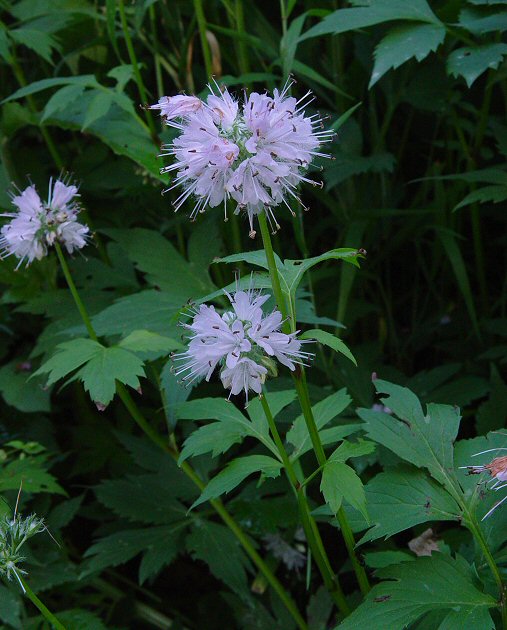Hydrophyllum virginianum L.
Virginia Waterleaf

Native
CC = 4
CW = 0
MOC = 58
© DETenaglia
Hydrophyllum virginianum L.Virginia Waterleaf | |
 |
Native CC = 4 CW = 0 MOC = 58 |
© DETenaglia |
|
Family - Hydrophyllaceae Habit - Perennial forb with scaly, usually long rhizomes, often forming large colonies. Stems - Ascending, to 60 cm, sometimes multiple from the base, nearly glabrous or sparsely to moderately pubescent with short, stiff, ascending hairs toward the tip, often also with sparse, slightly longer, spreading to downward-curved hairs.
Leaves - Basal and alternate, petiolate, deeply pinnatifid, with 3-7 lobes. Petioles reduced upward, those of basal leaves to 14 cm long. Blades 5-30 cm long, broadly ovate to broadly elliptic in outline, pinnately compound or very deeply lobed, the rachis slightly winged, the (usually 5) lobes mostly narrowed toward the base, the margins coarsely toothed or less commonly also few-lobed, the surfaces sparsely to moderately pubescent with, short, stiff, straight, appressed hairs, the upper surface scabrous and deep green, the undersurface sometimes nearly glabrous and pale green.
Inflorescence - Terminal scorpoid to capitate clusters usually extending above the leaves. Peduncles to 10 cm long, with antrorse pubescence. Pedicels to 5 mm long.
Flowers - Calyces 4-7 mm long, the lobes bristly-hairy along the margins and with shorter hairs on the outer surface, sometimes only near the base, the sinuses lacking appendages. Corollas 6-10 mm long, narrowly bell-shaped, deeply 5-lobed, glabrous externally, white to purplish-tinged. Stamens and style exserted 4-9 mm beyond the corolla. Stamens 5, adnate at the base of the corolla tube, alternating with the corolla lobes. Filaments white basally, purple at the apex, with floccose hairs in the middle portion of their length, other wise glabrous, to 1.4 cm long. Anthers purplish, 2.1 mm long. Ovary superior, conic, 1.5 mm long and broad, with dense erect white pubescence, unilocular. Placentation parietal. Style lilac, glabrous, 1.2 cm long. Stigma whitish, 2-lobed.
Flowering - April - July. Habitat - Bottomland and mesic forests, bases of bluffs, ravines, river flood plains. Origin - Native to the U.S. Other info. - This attractive species can be found scattered throughout much of Missouri and the northeastern quadrant of the continental U.S., also ranging into Canada. It is an easy species to identify in the field due to its divided leaves and striking flower clusters, which are held above the foliage. The plant is found in rich, moist, shaded areas. Photographs taken off the MKT Trail, Columbia, MO., 5-12-04 (DETenaglia); also at Shaw Nature Reserve, Franklin County, MO, 4-27-2010 and 5-7-2021, and at Danville Conservation Area, Montgomery County, MO, 5-23-2018 (SRTurner). |